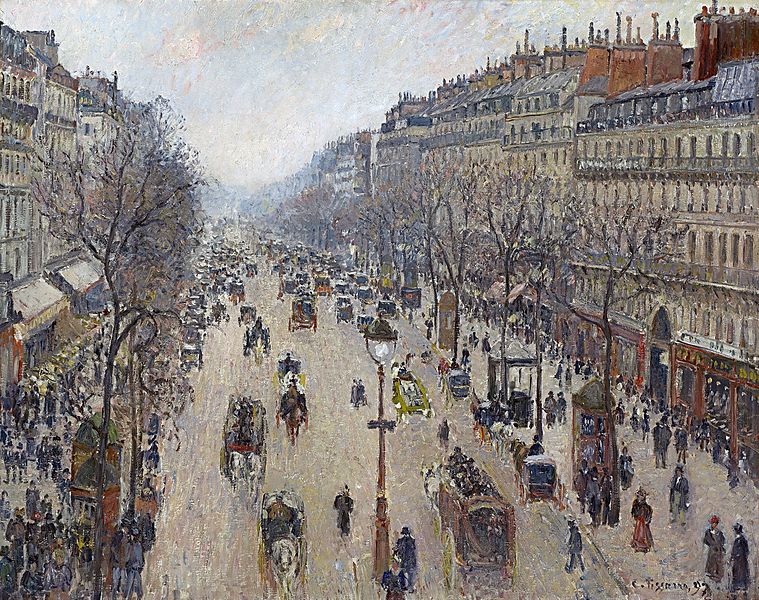The Boulevard Montmartre at Night
7:00 AM |
| Camille Pissarro, The Boulevard Montmartre at Night, 1897 |
Camille Pissarro, in the late 1880s, rented a room at the Grand Hôtel de Russie in Paris. This provided him with a view of the Boulevard Montmartre, which is one of the grand four boulevards in Paris. While the painting above depicts the street at night, Pissarro painted and painted this same view multiple times. In a series of works done in 1897, Pissarro painted the Boulevard Montmartre at four different times of day; morning, noon, evening, and night. Whether Pissarro marathoned all four of these paintings and finished them in one day or if they were all done separately, I don't know. Perhaps a bit of Monet's all-at-once painting technique had rubbed off on Pissarro. (If so, then I can understand why the brushstrokes on The Boulevard Montmartre at Night were more hurried than the rest. A man's gotta sleep, after all.)
 |
| The Boulevard Montmartre, Morning, Grey Weather, 1897 |
In his later years, Pissarro suffered from a reoccurring eye infection that confined the previously en plein air painter indoors. Thus, Pissarro worked from the inside looking out -- or down, rather -- from hotel rooms in Paris, as well as London. This change in venue also made Pissarro change his subject matter from that of Millet-esque peasants and nature to city streets. A vast and difficult change for any painter, but that's what I appreciate about Pissarro. He has the innate ability to switch painting styles and subjects at the drop of a hat. I can't say that Pissarro has any set style, one that would uniquely define him as a painter. He switched from watercolors to Impressionist, to pointillism, to Impressionist again. Thus, the day begins with The Boulevard Montmartre, Morning, Grey Weather. I wish I could present this in the intended size (Wikipedia has a quality, zoom-in-able version of this painting. I would recommend looking it up). Although collectively grey, it's extremely colorful and lively. Overcast weather is usually portrayed as melancholy and dull, but the small flecks of color in the people and buildings bring vitality to the canvas. A hint of red, a blip of yellow; Pissarro manages to somehow breathe life into this painting with the small things.
 |
| The Boulevard Montmartre: Afternoon, in the Rain, 1897 |
Part of me loves that fact that Pissarro painted the same boulevard fifteen times (that's not an exaggeration, it's an approximation), but it also drives me up the wall. The only difference to each painting is the the position of the people, the weather, and the trees. The man was obsessed. This always reminds me of Monet and his paintings of the Rouen Cathedral. He painted this same subject eight times (don't quote me on that), becoming obsessed with how the different times of day would light the cathedral walls. But he was never satisfied with his compositions, so much so that the cathedral haunted his dreams, giving him so many nightmares that he had to leave Paris. Did Pissarro ever dream of the Boulevard Montmartre? I'll come back to that thought.
 |
| Boulevard Montmartre, Sunset, 1897 |
So, now the clouds are mostly gone, and the sun shines golden light through Pissarro's boulevard. People pack the streets, a noticeable carriage traffic jam up ahead; everyone is heading home for the day. The crowded boulevard and noticeably shorter buildings make the Boulevard Montmartre, Sunset look weighted. It's not as smudgey as the afternoon, but not as detail oriented as the morning. Here, I think Pissarro struggles to find that balance, an equilibrium if you will, in his painting style. As I mentioned earlier, Pissarro's style often changed, and while that I see that as dexterity, I also see that as confusion. This caused many an "artistic crisis" for Pissarro, causing him to struggle to find his own signature style.
In The Boulevard Montmartre at Night, I believe he finds that. My favorite of the Boulevard series, The Boulevard Montmartre at Night is so different from the other three paintings that it hardly looks like the same artist. Returning to this idea, I believe Pissarro had to have dreamed about his boulevard. Looking at the painting, it's too dreamlike from him to not have. Except, unlike Monet, it wasn't a nightmare. The sky is dark and starless. Pissarro, instead, brings that celestial quality to the ground. The streetlights, previously lost in the commotion of the day, have their own star-like quality. It's no longer about the people or carriages that crowded the street, it's about the Boulevard Montmartre itself. He shows his love for the Boulevard Montmartre through these paintings, like a love affair (objectively, of course). And I have to admit, I'm obsessed.
0 comments